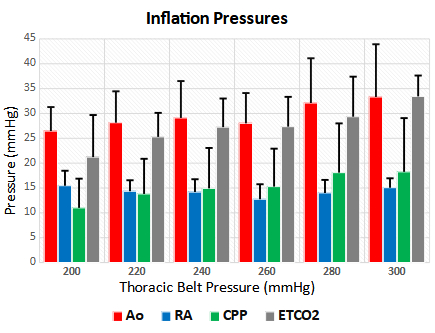Final ID: Su1009
Effect of Increasing Force on Perfusion Pressures During Circumferential Constriction Cardiopulmonary Resuscitation
Abstract Body:
Introduction: Outcomes after treatment with currently available CPR remain poor. CPR related injuries are associated with worse outcomes. In comparison to standard sternal piston-type CPR, the utilization of pneumatic circumferential constriction CPR (CC-CPR) enables the application of a greater motive force while minimizing localized injury force. This technique has the potential to enhance hemodynamics and reduce skeletal injuries. Nonetheless, the optimal pneumatic belt pressure for CC-CPR, which equates force around the chest, has not been comprehensively studied.
Hypothesis: CC-CPR with increasing force may be associated with improved perfusion pressures without increased skeletal injuries.
Methods: Ventricular fibrillation was induced in female Yorkshire swine (n = 7, 30-40 kg). CPR was provided by inflating a circumferential pneumatic ‘belt’ 80 times per minute. Belt pressures were varied in one-minute treatment epochs among 200, 220, 240, 260, and 280mmHg. Aortic (Ao) and right atrial (RA) pressures were measured using micromanometer catheters. Coronary perfusion pressure (CPP) was derived as the difference between the Ao and RA pressures at the end of the decompression phase. Airway end-tidal CO2 (ETCO2) was recorded as a secondary indicator of cardiac output. At the end of each experiment, animals were examined for rib fractures on postmortem. Results from all experiments were grouped by treatment type and evaluated by ANOVA.
Results: Increasing pneumatic belt pressures were associated with a trend toward higher CPPS and a significant increase in ETCO2 (P < 0.01) (See Figure). There were no palpable rib fractures in any of the animals, despite occasional constriction pressures as high as 300mmHg (5.8 PSI). Necropsy revealed visceral organ injury in some of the animals, but this could not be attributed to any specific CPR pressure.
Conclusion: During CC-CPR, higher pneumatic belt pressures were associated with increased CPPs and ETCO2. Pressures as high as 300mmHg did not cause skeletal fractures. These trends may be affected by also optimizing rate and duty cycle. If confirmed in other models, higher belt pressures during CC-CPR merit evaluation in human clinical studies.
Introduction: Outcomes after treatment with currently available CPR remain poor. CPR related injuries are associated with worse outcomes. In comparison to standard sternal piston-type CPR, the utilization of pneumatic circumferential constriction CPR (CC-CPR) enables the application of a greater motive force while minimizing localized injury force. This technique has the potential to enhance hemodynamics and reduce skeletal injuries. Nonetheless, the optimal pneumatic belt pressure for CC-CPR, which equates force around the chest, has not been comprehensively studied.
Hypothesis: CC-CPR with increasing force may be associated with improved perfusion pressures without increased skeletal injuries.
Methods: Ventricular fibrillation was induced in female Yorkshire swine (n = 7, 30-40 kg). CPR was provided by inflating a circumferential pneumatic ‘belt’ 80 times per minute. Belt pressures were varied in one-minute treatment epochs among 200, 220, 240, 260, and 280mmHg. Aortic (Ao) and right atrial (RA) pressures were measured using micromanometer catheters. Coronary perfusion pressure (CPP) was derived as the difference between the Ao and RA pressures at the end of the decompression phase. Airway end-tidal CO2 (ETCO2) was recorded as a secondary indicator of cardiac output. At the end of each experiment, animals were examined for rib fractures on postmortem. Results from all experiments were grouped by treatment type and evaluated by ANOVA.
Results: Increasing pneumatic belt pressures were associated with a trend toward higher CPPS and a significant increase in ETCO2 (P < 0.01) (See Figure). There were no palpable rib fractures in any of the animals, despite occasional constriction pressures as high as 300mmHg (5.8 PSI). Necropsy revealed visceral organ injury in some of the animals, but this could not be attributed to any specific CPR pressure.
Conclusion: During CC-CPR, higher pneumatic belt pressures were associated with increased CPPs and ETCO2. Pressures as high as 300mmHg did not cause skeletal fractures. These trends may be affected by also optimizing rate and duty cycle. If confirmed in other models, higher belt pressures during CC-CPR merit evaluation in human clinical studies.
More abstracts on this topic:
A Porcine Model of Cardiac Arrest Without Pre-Arrest Fluid Loading, Sternal Molding, or Epinephrine
Paradis Aidan, Paradis Norman, Gaddy David, Moodie Karen, Mader Timothy, Dufresne Alexandre, Couturier Christine, Dufresne Simon, Davis Daniel, Sims Christopher
Adapting Chest Compressions to Variable Chest Dynamics in Out-of-Hospital CPRUriguen Jose Antonio, Leturiondo Mikel, Daya Mohamud, Russell James

